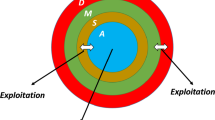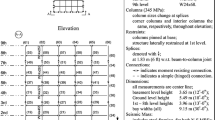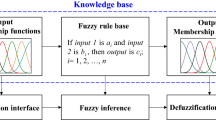Abstract
Optimum structural design of composites is a research subject that has drawn the attention of many researchers for more than 40 years with a growing interest. In many cases, the loads acting on a composite structure may not be known precisely. Therefore, to design a fuzzy intelligent system, the datasets including general information about MDOF systems subjected to different earthquakes were used. The proportional major operation of the designed fuzzy system based on solving linear matrix inequality method optimized and derived by stability analysis of the system behavior. Because the design of efficient and high-performance structural systems is of fundamental interest to engineers, systematic methodologies are to be used for the combined structural and active control system synthesis in many applications. Based on the relaxed method, the intelligent approach can be stabilized by regulating appropriately the parameters of high-frequency injection. If the frequency is high enough, the trajectory of the closed-loop system and that of its corresponding model—the closed-loop fuzzy relaxed system can be made as close as desired. Thus, the closed-loop system’s behavior can be rigorously predicted by establishing the stability of the closed-loop fuzzy relaxed system.


Similar content being viewed by others
Change history
10 December 2023
This article has been retracted. Please see the Retraction Notice for more detail: https://doi.org/10.1007/s40996-023-01303-7
References
Azevedo A, Rezende SM (1991) Controlling chaos in spin-wave instabilities. Phys Rev Lett 66:1342–1345
Chen BS, Wang WJ (1990) Robust stabilization of nonlinearly perturbed large-scale systems by decentralized observer-controller compensators. Automatica 26:1035–1041
Chu SC, Tsai PW (2007) Computational intelligence based on behaviors of cats. Int J Innov Comput Inf Control 3(1):163–173
Chu SC, Tsai PW, Pan JS (2006) Cat swarm optimization. In: Proceedings of trends in artificial intelligence, 9th Pacific Rim international conference on artificial intelligence, Guilin, China, pp 854–858
Colet P, Braiman Y (1996) Control of chaos in multimode solid state lasers by the use of small periodic perturbations. Phys Rev E 53:200–206
Desoer CA, Shahruz SM (1986) Stability of the dithered nonlinear system with backlash or hysteresis. Int J Control 43:1045–1060
Harms VW (1979) Design criteria for floating tire breakwaters. J Waterw Port Coast Ocean Div ASCE 105(2):149–170
Hwang CC, Chow HY, Wang YK (1996) A new feedback control of a modified Chua’s circuit system. Phys D 92:95–100
Jabbari F, Sehmitendorf WE, Yang JN (1995) H∞ control for seismic excited buildings with acceleration feedback. J Eng Mech 21:994–1002
Kapitaniak T, Kocarev LJ, Chua LO (1993) Controlling chaos without feedback and control signals. Int J Bifurc Chaos 3:459–468
Kickert WJM, Mamdani EH (1978) Analysis of a fuzzy logic controller. Fuzzy Sets Syst 1(1):29–44
Liu SC, Lin SF (2012) LMI-based robust sliding control for mismatched uncertain nonlinear systems using fuzzy models. Int J Robust Nonlinear Control 22(16):1827–1836
Liu SC, Lin SF (2013) Robust sliding control for mismatched uncertain fuzzy time-delay systems using linear matrix inequality approach. J Chin Inst Eng 36(5):589–597
Lu LT, Chiang WL, Tang JP (1998) LQG/LTR control methodology in active structure control. J Eng Mech ASCE 124(4):446–454
Mossaheb S (1983) Application of a method of averaging to the study of dithers in nonlinear systems. Int J Control 38:557–576
Ott E, Grebogi C, Yorke JA (1990) Controlling chaos. Phys Rev Lett 64:1196–1199
Schmitendorf WE, Jabbari F, Yang JN (1994) Robust control techniques for buildings under earthquake excitation. Earthq Eng Struct Dyn 23:539–552
Shen W, Zhu S, Zhu H, Xu Y-L (2016) Electromagnetic energy harvesting from structural vibrations during earthquakes. Smart Struct Syst 18(449–470):32
Singer J, Wang YT, Bau HH (1991) Experimental control of chaos. Phys Rev Lett 66:1123–1125
Steinberg AM, Kadushin I (1973) Stabilization of nonlinear systems with dither control. J Math Anal Appl 43:273–284
Takagi T, Sugeno M (1985) Fuzzy identification of systems and its applications to modeling and control. IEEE Trans Syst Man Cybern 1:116–132
Tanaka K, Wang HO (2001) Fuzzy control systems design and analysis. Wiley, New York
Tose AR (1994) Nonlinear feedback for controlling the Lorenz equation. Phys Rev E 50:2339–2342
Tsai PW, Pan JS, Liao BY, Tsai MJ, Istanda V (2012) Bat algorithm inspired algorithm for solving numerical optimization problems. Appl Mech Mater 148:134–137
Wang HO, Abed EH (1995) Bifurcation control of a chaotic system. Automatica 31:1213–1226
Wang HO, Tanaka K, Griffin MF (1996) An approach to fuzzy control of nonlinear systems: stability and design issues. IEEE Trans Fuzzy Syst 4:14–23
Yamamoto T, Yoshida A, Ijima T (1982) Dynamics of elastically moored floating objects. In: Kirk CL (ed) Dynamic analysis of offshore structures. CML, Southampton, pp 106–113
Zames G, Shneydor NA (1976) Dither in nonlinear systems. IEEE Trans Autom Control 21:660–667
Zames G, Shneydor NA (1977) Structural stabilization on quenching by dither in nonlinear systems. IEEE Trans Autom Control 22:353–361
Author information
Authors and Affiliations
Corresponding author
Additional information
This article has been retracted. Please see the retraction notice for more detail: https://doi.org/10.1007/s40996-023-01303-7"
Rights and permissions
Springer Nature or its licensor (e.g. a society or other partner) holds exclusive rights to this article under a publishing agreement with the author(s) or other rightsholder(s); author self-archiving of the accepted manuscript version of this article is solely governed by the terms of such publishing agreement and applicable law.
About this article
Cite this article
Chen, T., Rao, S., Sabitovich, R.T. et al. RETRACTED ARTICLE:An Intelligent Algorithm Optimum for Building Design of Fuzzy Structures. Iran J Sci Technol Trans Civ Eng 44, 523–531 (2020). https://doi.org/10.1007/s40996-019-00251-5
Received:
Accepted:
Published:
Issue Date:
DOI: https://doi.org/10.1007/s40996-019-00251-5




